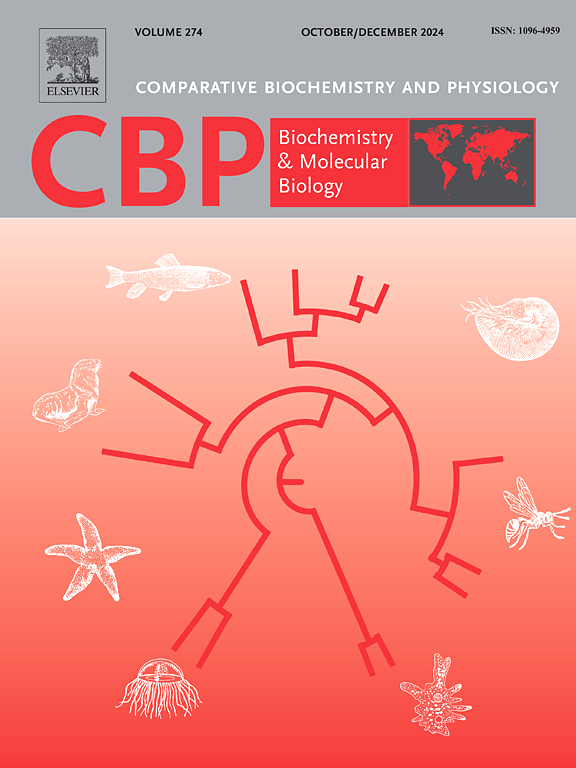Effect of prebiotics added to the culture water on the bacterial profiles of biofloc and the gills, hepatopancreas, and intestine of Penaeus vannamei
IF 1.9
3区 生物学
Q4 BIOCHEMISTRY & MOLECULAR BIOLOGY
Comparative Biochemistry and Physiology B-Biochemistry & Molecular Biology
Pub Date : 2025-04-01
DOI:10.1016/j.cbpb.2025.111097
引用次数: 0
Abstract
Prebiotics alter microbial communities by supplying carbon to specific bacteria that benefit the host. However, the effect of prebiotics added to the culture water on shrimp production and bacterial composition has not been demonstrated. Therefore, this study evaluated the effects of four prebiotics — short-chain fructooligosaccharide, galactooligosaccharide, inulin, and mannan-oligosaccharide — and two non-prebiotic carbohydrates — sucrose and wheat starch — on shrimp growth, nutrient composition of shrimp muscle and biofloc, biofloc concentration, and bacterial profiles in biofloc and gills, hepatopancreas, and intestine of Penaeus vannamei. Shrimp (6.0 ± 0.5 g) were stocked into 36 tanks (72 shrimp/m2) and raised in a biofloc technology system consisting of two phases: an autotrophic-dominated phase (days 0–4) and a heterotrophic-dominated phase (days 5–26). The prebiotic and non-prebiotic carbohydrates were added to the water at a rate of 3 % of the feed provided. Key findings revealed that adding prebiotics to the water did not affect shrimp growth. Notably, shrimp muscle from the mannan-oligosaccharide treatment exhibited a significantly higher lipid content than that from the galactooligosaccharide treatment (p ≤ 0.05). No significant effect was observed on the nutrient composition of biofloc. Biofloc concentration was lower in the wheat starch treatment (p ≤ 0.05). Finally, the prebiotics altered the bacterial composition of biofloc and shrimp gills, hepatopancreas, and intestine. These results revealed that adding prebiotics to the culture water of a biofloc system has an effect on shrimp quality and microbial communities of biofloc and various shrimp tissues, suggesting their potential benefit on shrimp production and health.

在培养水中添加益生元对凡纳滨对虾生物群落及鳃、肝胰腺和肠道细菌分布的影响。
益生素通过向特定细菌提供碳来改变微生物群落,从而使宿主受益。然而,添加到养殖水中的益生元对对虾产量和细菌组成的影响尚未得到证实。因此,本研究评估了四种益生元(短链果寡糖、半乳寡糖、菊粉和甘露寡糖)和两种非益生元碳水化合物(蔗糖和小麦淀粉)对对虾生长、对虾肌肉和生物絮团的营养成分、生物絮团浓度以及生物絮团、对虾鳃、肝胰脏和肠道中细菌特征的影响。将对虾(6.0 ± 0.5 克)放入 36 个水箱(72 只/平方米),在生物絮凝技术系统中养殖,该系统包括两个阶段:自养为主的阶段(第 0-4 天)和异养为主的阶段(第 5-26 天)。益生菌和非益生碳水化合物按所提供饲料的 3% 的比例添加到水中。主要研究结果表明,在水中添加益生素不会影响虾的生长。值得注意的是,来自甘露寡糖处理的对虾肌肉的脂质含量明显高于来自半乳寡糖处理的对虾肌肉的脂质含量(p ≤ 0.05)。生物絮凝物的营养成分没有受到明显影响。小麦淀粉处理的生物絮凝物浓度较低(p ≤ 0.05)。最后,益生素改变了生物絮凝物和对虾鳃、肝胰腺和肠道的细菌组成。这些结果表明,在生物絮团系统的养殖水中添加益生素对对虾的质量以及生物絮团和对虾各种组织的微生物群落有影响,表明益生素对对虾的生产和健康有潜在的益处。
本文章由计算机程序翻译,如有差异,请以英文原文为准。
求助全文
约1分钟内获得全文
求助全文
来源期刊
CiteScore
4.60
自引率
4.50%
发文量
77
审稿时长
22 days
期刊介绍:
Comparative Biochemistry & Physiology (CBP) publishes papers in comparative, environmental and evolutionary physiology.
Part B: Biochemical and Molecular Biology (CBPB), focuses on biochemical physiology, primarily bioenergetics/energy metabolism, cell biology, cellular stress responses, enzymology, intermediary metabolism, macromolecular structure and function, gene regulation, evolutionary genetics. Most studies focus on biochemical or molecular analyses that have clear ramifications for physiological processes.

 求助内容:
求助内容: 应助结果提醒方式:
应助结果提醒方式:


